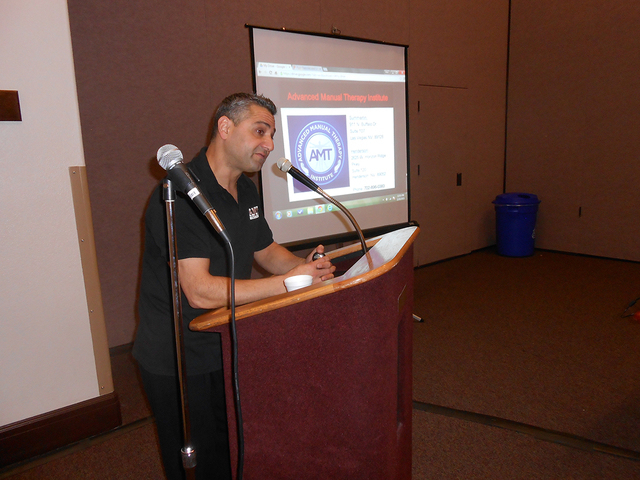Modern pain theories help explain variety of sensations
When someone says that pain is all in your head, they’re partially right. New theories on pain and how the human body perceives it are changing how the medical industry treats people experiencing pain.
Michel Rantissi, who holds a doctorate in physical therapy, treats people at the Advanced Manual Therapy Institute, 911 N. Buffalo Drive, Suite 107. He spoke to about 500 Sun City Summerlin residents Feb. 24 at the Desert Vista Community Center, 10360 Sun City Blvd.
Marie, who declined to give her last name, attended to get information.
“When you reach my age, you have so many pain issues, but it’s not to the point where I can’t get around and all that,” the 75-year-old said.
Raymond Pun, 77, was experiencing pain behind his right shoulder. “I’ve been going to the gym and doing barbells and stretching and exercising, so it’s better now. I (want to learn) about pain and what causes it and what you can do about it.”
Rantissi said the medical community’s take on pain has changed greatly.
“Telling you it was in your head and making you feel like you were crazy is not the way it should have been done,” he said. “Pain is very complex. … It involves not just negative stimuli but your experiences, your beliefs, your culture, your religion, your knowledge, your body image; pretty much every thing about you will dictate how you respond and accept pain.”
He said 100 million Americans suffer from chronic pain, and chronic pain heath care costs were $600 billion in 2010. A lot of that was related to lower back pain.
Acute pain can be from a fresh injury, less than 30 days old. The doctor said it was the most important window of time in which to heal oneself. Treat it with RICE — rest, ice, compression and elevation.
“People are always asking me, what should I use, heat or ice? If it’s a fresh injury, you always start with ice,” he said. “You’re inflamed. If you bring heat to that area with a hot pack, you’ll bring more inflammation, and that’s your No. 1 culprit to healing, inflammation.”
Up until 1664, pain theories had an otherworldly tone. Pain was the devil’s work. Rene Descartes’ Specificity Theory of Pain changed that, suggesting that injuries activated specific pain receptors that projected pain impulses to the brain.
In 1965, Ronald Melzack and Patrick Wall proposed the Gate Control Theory in which thin pain and large-diameter pain were relayed by different nerve sizes.
Curiously, one old wive’s tale is based in science.
“We’ve learned as humans that if something hurts, rub it out,” Rantissi said. “That’s where Mama’s kiss came from.”
Such action affects the electrical stimulation units and covers up the pain, he explained.
In 1990 came the neuromatrix theory in which pain is found in the head. It proposed that “the brain can create qualities we feel from the body in the absence of impulses from the pain, so I have phantom foot pain if I’ve lost a limb,” the doctor said. “ … Every (amputee) you talk to, they’ll discuss how they feel pain in their foot, their toes, their leg, even though it’s not there.”
In recent years, doctors have realized the pain message includes a series of receptors in the head, involving sections of the brain that deal with emotion, memory and the thought processes.
“This matrix covers almost the whole brain except for the back cortex of the brain; there’s no way for it not to be involved with your life. … If you’ve had a traumatic life, pain is probably going to make it more traumatic for you,” Rantissi said. “If you had a happy life, pain may not be as severe because you’re not stimulating other memories. … If I took a hammer to two different people’s fingers, they will respond in two different ways because of how they were brought up and what their beliefs are.”
If it gets to chronic pain and you’re ignoring it, letting it build upon itself, all you’re doing is letting these pathways become more permanent, he said. It becomes embedded.
The placebo effect has been scientifically proven.
“It was once thought to be purely psychological,” he said. “Now, it’s believed to be neuro-chemical. … Believing that treatment will work can be enough to activate endogenous opioid receptors and cause relief in your system.”
He said by being told you’ll be better and giving yourself positive input as you heal, you’ll have better results.
“If you’re not coming in (to physical therapy) with a good attitude, I could be God and not heal you,” he said, “because you already have it in your brain that you’re not going to get better.”
To reach Summerlin Area View reporter Jan Hogan, email jhogan@viewnews.com or call 702-387-2949.


















